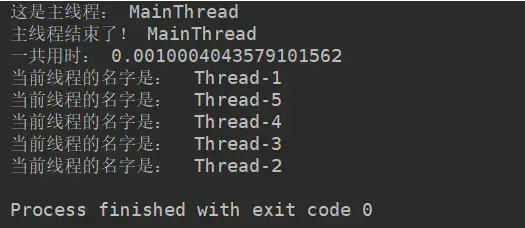Python多線程以及多線程中join()的使用方法示例
Python多線程與多進程中join()方法的效果是相同的。
下面僅以多線程為例:
首先需要明確幾個概念:
知識點一:
當一個進程啟動之後,會默認產生一個主線程,因為線程是程序執行流的最小單元,當設置多線程時,主線程會創建多個子線程,在python中,默認情況下(其實就是setDaemon(False)),主線程執行完自己的任務以後,就退出瞭,此時子線程會繼續執行自己的任務,直到自己的任務結束,
見下面 例子一。
知識點二:
當我們使用setDaemon(True)方法,設置子線程為守護線程時,主線程一旦執行結束,則全部線程全部被終止執行,可能出現的情況就是,子線程的任務還沒有完全執行結束,就被迫停止,
見下面例子二。
知識點三:
此時join的作用就凸顯出來瞭,join所完成的工作就是線程同步,即主線程任務在設置join函數的地方,進入阻塞狀態,一直等待其他的子線程執行結束之後,主線程再開始執行直到終止終止,
例子見下面三。
知識點四:
join有一個timeout參數:
- 當有設置守護線程時,含義是主線程對於子線程等待timeout的時間將會殺死該子線程,最後退出程序。所以說,如果有10個子線程,全部的等待時間就是每個timeout的累加和。簡單的來說,就是給每個子線程一個timeout的時間,讓他去執行,時間一到,不管任務有沒有完成,直接殺死。
- 沒有設置守護線程時,主線程將會等待timeout的累加和這樣的一段時間,時間一到,主線程結束,但是並沒有殺死子線程,子線程依然可以繼續執行,直到子線程全部結束,程序退出。
一:Python多線程的默認情況
import threading
import time
def run():
time.sleep(2)
print('當前線程的名字是: ', threading.current_thread().name)
time.sleep(2)
if __name__ == '__main__':
start_time = time.time()
print('這是主線程:', threading.current_thread().name)
thread_list = []
for i in range(5):
t = threading.Thread(target=run)
thread_list.append(t)
for t in thread_list:
t.start()
print('主線程結束!' , threading.current_thread().name)
print('一共用時:', time.time()-start_time)
其執行結果如下:

關鍵:
- 計時是對主線程計時,主線程結束,計時隨之結束,打印出主線程的用時。
- 主線程的任務完成之後,主線程隨之結束,子線程繼續執行自己的任務,直到全部的子線程的任務全部結束,程序結束。
二:設置守護線程
import threading
import time
def run():
time.sleep(2)
print('當前線程的名字是: ', threading.current_thread().name)
time.sleep(2)
if __name__ == '__main__':
start_time = time.time()
print('這是主線程:', threading.current_thread().name)
thread_list = []
for i in range(5):
t = threading.Thread(target=run)
thread_list.append(t)
for t in thread_list:
t.setDaemon(True)
t.start()
print('主線程結束瞭!' , threading.current_thread().name)
print('一共用時:', time.time()-start_time)
註意:註意請確保setDaemon()在start()之前
其執行結果如下:

關鍵點:
非常明顯的看到,主線程結束以後,子線程還沒有來得及執行,整個程序就退出瞭。
三:join的作用
import threading
import time
def run():
time.sleep(2)
print('當前線程的名字是: ', threading.current_thread().name)
time.sleep(2)
if __name__ == '__main__':
start_time = time.time()
print('這是主線程:', threading.current_thread().name)
thread_list = []
for i in range(5):
t = threading.Thread(target=run)
thread_list.append(t)
for t in thread_list:
t.setDaemon(True)
t.start()
for t in thread_list:
t.join()
print('主線程結束瞭!' , threading.current_thread().name)
print('一共用時:', time.time()-start_time)
其執行結果如下:

關鍵點:
可以看到,主線程一直等待全部的子線程結束之後,主線程自身才結束,程序退出。
主程序意外退出的情況
在線程A中使用B.join()表示線程A在調用join()處被阻塞,且要等待線程B的完成才能繼續執行
import threading
import time
def child_thread1():
for i in range(10):
time.sleep(1)
print('child_thread1_running...')
def child_thread2():
for i in range(5):
time.sleep(1)
print('child_thread2_running...')
def parent_thread():
print('parent_thread_running...')
thread1 = threading.Thread(target=child_thread1)
thread2 = threading.Thread(target=child_thread2)
thread1.setDaemon(True)
thread2.setDaemon(True)
thread1.start()
thread2.start()
thread2.join()
1/0
thread1.join()
print('parent_thread_exit...')
if __name__ == "__main__":
parent_thread()
輸出:
parent_thread_running…
child_thread1_running…
child_thread2_running…
child_thread1_running…
child_thread2_running…
child_thread1_running…
child_thread2_running…
child_thread1_running…
child_thread2_running…
child_thread1_running…
child_thread2_running…
Traceback (most recent call last):
File “E:/test_thread.py”, line 31, in <module>
parent_thread()
File “E:/test_thread.py”, line 25, in parent_thread
1/0
ZeroDivisionError: integer division or modulo by zero
主線程在執行到thread2.join()時被阻塞,等待thread2結束後才會執行下一句
1/0會使主線程報錯退出,且thread1設置瞭daemon=True,因此主線程意外退出時thread1也會立即結束。thread1.join()沒有被主線程執行
總結
到此這篇關於Python多線程以及多線程中join()使用的文章就介紹到這瞭,更多相關Python多線程join()的用法內容請搜索WalkonNet以前的文章或繼續瀏覽下面的相關文章希望大傢以後多多支持WalkonNet!
推薦閱讀:
- Python threading和Thread模塊及線程的實現
- Python多線程編程入門詳解
- Python多線程即相關理念詳解
- 分析Python感知線程狀態的解決方案之Event與信號量
- 深入瞭解Python的多線程基礎